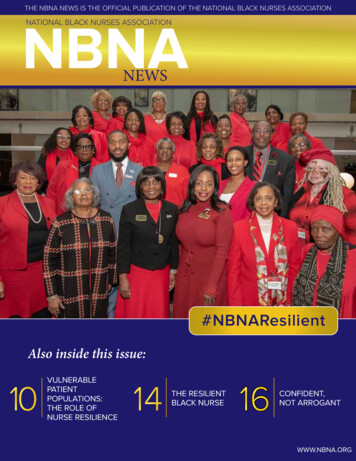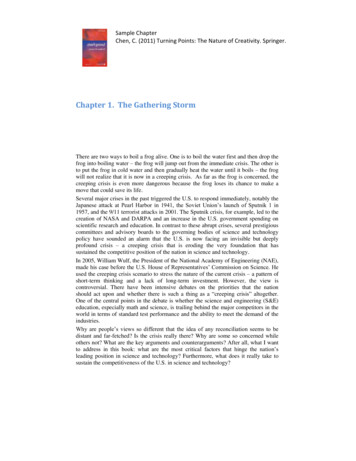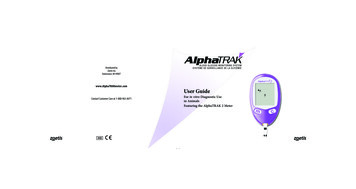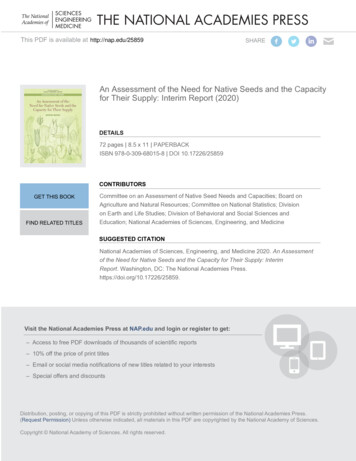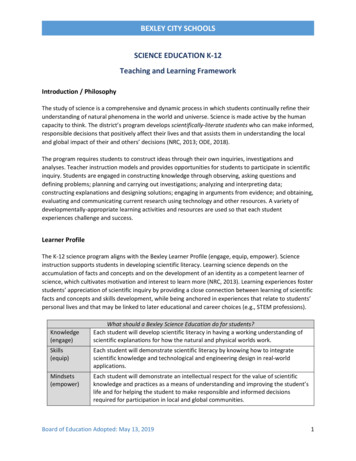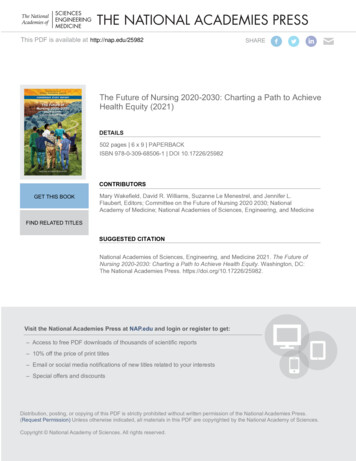
Transcription
THE NATIONAL ACADEMIES PRESSThis PDF is available at http://nap.edu/25982SHARE The Future of Nursing 2020-2030: Charting a Path to AchieveHealth Equity (2021)DETAILS502 pages 6 x 9 PAPERBACKISBN 978-0-309-68506-1 DOI 10.17226/25982CONTRIBUTORSGET THIS BOOKMary Wakefield, David R. Williams, Suzanne Le Menestrel, and Jennifer L.Flaubert, Editors; Committee on the Future of Nursing 2020 2030; NationalAcademy of Medicine; National Academies of Sciences, Engineering, and MedicineFIND RELATED TITLESSUGGESTED CITATIONNational Academies of Sciences, Engineering, and Medicine 2021. The Future ofNursing 2020-2030: Charting a Path to Achieve Health Equity. Washington, DC:The National Academies Press. https://doi.org/10.17226/25982.Visit the National Academies Press at NAP.edu and login or register to get:– Access to free PDF downloads of thousands of scientific reports– 10% off the price of print titles– Email or social media notifications of new titles related to your interests– Special offers and discounts Distribution, posting, or copying of this PDF is strictly prohibited without written permission of the National Academies Press.(Request Permission) Unless otherwise indicated, all materials in this PDF are copyrighted by the National Academy of Sciences.Copyright National Academy of Sciences. All rights reserved.
The Future of Nursing 2020-2030: Charting a Path to Achieve Health EquityMary K. Wakefield, David R. Williams, Suzanne Le Menestrel, andJennifer L. Flaubert, EditorsCommittee on the Future of Nursing 2020–2030NATIONAL ACADEMY OF MEDICINEPREPUBLICATION COPY—Uncorrected ProofsCopyright National Academy of Sciences. All rights reserved.
The Future of Nursing 2020-2030: Charting a Path to Achieve Health EquityTHE NATIONAL ACADEMIES PRESS 500 Fifth Street, NW Washington, DC 20001This activity was supported by a contract between the National Academy ofSciences and the Robert Wood Johnson Foundation (Grant Number 76081). Anyopinions, findings, conclusions, or recommendations expressed in this publicationdo not necessarily reflect the views of any organization or agency that providedsupport for the project.International Standard Book Number-13: 978-0-309-XXXXX-XInternational Standard Book Number-10: 0-309-XXXXX-XDigital Object Identifier: https://doi.org/10.17226/25982Library of Congress Control Number:Additional copies of this publication are available from the National AcademiesPress, 500 Fifth Street, NW, Keck 360, Washington, DC 20001; (800) 624-6242or (202) 334-3313; http://www.nap.edu.Copyright 2021 by the National Academy of Sciences. All rights reserved.Printed in the United States of AmericaSuggested citation: National Academies of Sciences, Engineering, and Medicine.2021. The future of nursing 2020–2030: Charting a path to achieve health equity.Washington, DC: The National Academies Press. https://doi.org/10.17226/25982.PREPUBLICATION COPY—Uncorrected ProofsCopyright National Academy of Sciences. All rights reserved.
The Future of Nursing 2020-2030: Charting a Path to Achieve Health EquityThe National Academy of Sciences was established in 1863 by an Actof Congress, signed by President Lincoln, as a private, nongovernmentalinstitution to advise the nation on issues related to science and technology.Members are elected by their peers for outstanding contributions toresearch. Dr. Marcia McNutt is president.The National Academy of Engineering was established in 1964 underthe charter of the National Academy of Sciences to bring the practices ofengineering to advising the nation. Members are elected by their peersfor extraordinary contributions to engineering. Dr. John L. Anderson ispresident.The National Academy of Medicine (formerly the Institute of Medicine)was established in 1970 under the charter of the National Academy ofSciences to advise the nation on medical and health issues. Members areelected by their peers for distinguished contributions to medicine andhealth. Dr. Victor J. Dzau is president.The three Academies work together as the National Academies ofSciences, Engineering, and Medicine to provide independent, objective analysis and advice to the nation and conduct other activities tosolve complex problems and inform public policy decisions. The NationalAcademies also encourage education and research, recognize outstanding contributions to knowledge, and increase public understanding inmatters of science, engineering, and medicine.Learn more about the National Academies of Sciences, Engineering, andMedicine at www.nationalacademies.org.PREPUBLICATION COPY—Uncorrected ProofsCopyright National Academy of Sciences. All rights reserved.
The Future of Nursing 2020-2030: Charting a Path to Achieve Health EquityConsensus Study Reports published by the National Academiesof Sciences, Engineering, and Medicine document the evidencebased consensus on the study’s statement of task by an authoringcommittee of experts. Reports typically include findings, conclusions,and recommendations based on information gathered by thecommittee and the committee’s deliberations. Each report has beensubjected to a rigorous and independent peer-review process and itrepresents the position of the National Academies on the statement oftask.Proceedings published by the National Academies of Sciences,Engineering, and Medicine chronicle the presentations and discussionsat a workshop, symposium, or other event convened by the NationalAcademies. The statements and opinions contained in proceedings arethose of the participants and are not endorsed by other participants, theplanning committee, or the National Academies.For information about other products and activities of the NationalAcademies, please visit ATION COPY—Uncorrected ProofsCopyright National Academy of Sciences. All rights reserved.
The Future of Nursing 2020-2030: Charting a Path to Achieve Health EquityCOMMITTEE ON THE FUTURE OF NURSING 2020–2030MARY K. WAKEFIELD (Co-Chair), Visiting Professor, The University ofTexas at AustinDAVID R. WILLIAMS (Co-Chair), Florence and Laura Norman Professor ofPublic Health and Chair, Department of Social and Behavioral Sciences,T.H. Chan School of Public Health, and Professor, Department of Africanand African American Studies, Harvard UniversityMAUREEN BISOGNANO, President Emerita and Senior Fellow, Institute forHealthcare ImprovementJEFFREY BRENNER, Co-Founder and Chief Medical Officer, JunaCarePETER I. BUERHAUS, Professor of Nursing, College of Nursing, andDirector, Center for Interdisciplinary Health Workforce Studies, MontanaState UniversityMARSHALL H. CHIN, Richard Parrillo Family Professor of HealthcareEthics, Department of Medicine, University of ChicagoREGINA S. CUNNINGHAM, Chief Executive Officer, Hospital of theUniversity of Pennsylvania; Adjunct Professor and Assistant Dean, Schoolof Nursing, University of PennsylvaniaJOSÉ J. ESCARCE, Distinguished Professor of Medicine, David GeffenSchool of Medicine, and Distinguished Professor of Health Policy andManagement, Fielding School of Public Health, University of California,Los AngelesGREER GLAZER, Schmidlapp Professor of Nursing and Dean, College ofNursing, University of CincinnatiMARCUS HENDERSON, Charge Nurse, Adolescent Services, FairmountBehavioral Health System; Lecturer, School of Nursing, University ofPennsylvaniaANGELICA MILLAN, Former Children’s Medical Services Nursing Director,County of Los Angeles Department of Public HealthJOHN W. ROWE, Julius B. Richmond Professor of Health Policy and Aging,Mailman School of Public Health, Columbia UniversityWILLIAM M. SAGE, James R. Dougherty Chair for Faculty Excellence,School of Law, and Professor of Surgery and Perioperative Care, DellMedical School, The University of Texas at AustinVICTORIA L. TIASE, Director of Research Science and Informatics Strategy,NewYork-Presbyterian HospitalWINSTON WONG, Scholar in Residence, University of California, LosAngeles, Kaiser Permanente Center for Health EquityvPREPUBLICATION COPY—Uncorrected ProofsCopyright National Academy of Sciences. All rights reserved.
The Future of Nursing 2020-2030: Charting a Path to Achieve Health EquityStudy StaffSUZANNE LE MENESTREL, Study Director (from June 2020)SUSAN B. HASSMILLER, Senior Scholar in Residence and Advisor to thePresident on Nursing, National Academy of MedicineJENNIFER LALITHA FLAUBERT, Program OfficerADRIENNE FORMENTOS, Research AssociateTOCHI OGBU-MBADIUGHA, Senior Program Assistant (from October2020)CARY HAVER, Study Director (until June 2020)LORI BRENIG, Senior Program Assistant (until May 2020)CAROL SANDOVAL, Senior Program Assistant (until September 2020)ASHLEY DARCY-MAHONEY, National Academy of Medicine DistinguishedNurse Scholar-in-Residence (August 2020 to August 2021)ALLISON SQUIRES, National Academy of Medicine Distinguished NurseScholar-in-Residence (March 2019 to August 2020)SHARYL NASS, Senior Board Director, Board on Health Care ServicesviPREPUBLICATION COPY—Uncorrected ProofsCopyright National Academy of Sciences. All rights reserved.
The Future of Nursing 2020-2030: Charting a Path to Achieve Health EquityReviewersThis Consensus Study Report was reviewed in draft form by individualschosen for their diverse perspectives and technical expertise. The purpose of thisindependent review is to provide candid and critical comments that will assistthe National Academies of Sciences, Engineering, and Medicine in making eachpublished report as sound as possible and to ensure that it meets the institutional standards for quality, objectivity, evidence, and responsiveness to the studycharge. The review comments and draft manuscript remain confidential to protectthe integrity of the deliberative process.We thank the following individuals for their review of this report:FRANK BAEZ, New York University Langone HealthKENYA V. BEARD, Chamberlain UniversityPATRICIA FLATLEY BRENNAN, National Library of MedicineSALLY S. COHEN, New York UniversityMARY PAT COUIG, The University of New MexicoFRANCIS J. CROSSON, Kaiser Permanente Bernard J. Tyson School ofMedicineWILLIAM A. DARITY, JR., Duke UniversityMARGARET FLINTER, Community Health Center, Inc.BIANCA K. FROGNER, University of WashingtonEMILY A. HAOZOUS, The University of New MexicoBERNADETTE MAZUREK MELNYK, The Ohio State UniversityTERI A. MURRAY, Saint Louis UniversityDANIEL J. PESUT, University of MinnesotaKRISTINE QURESHI, University of Hawai’i at MānoaviiPREPUBLICATION COPY—Uncorrected ProofsCopyright National Academy of Sciences. All rights reserved.
The Future of Nursing 2020-2030: Charting a Path to Achieve Health EquityviiiREVIEWERSROBERT D. REISCHAUER, The Urban InstituteCAROL A. ROMANO, Uniformed Services University of the HealthSciencesSUSAN E. STONE, Frontier Nursing University and American College ofNurse-MidwivesDANIEL WEBERG, The Ohio State UniversityAlthough the reviewers listed above provided many constructive commentsand suggestions, they were not asked to endorse the conclusions or recommendations of this report, nor did they see the final draft before its release. The reviewof this report was overseen by BOBBIE BERKOWITZ, Columbia University,and MAXINE HAYES, University of Washington. They were responsible formaking certain that an independent examination of this report was carried outin accordance with the standards of the National Academies and that all reviewcomments were carefully considered. Responsibility for the final content restsentirely with the authoring committee and the National Academies.PREPUBLICATION COPY—Uncorrected ProofsCopyright National Academy of Sciences. All rights reserved.
The Future of Nursing 2020-2030: Charting a Path to Achieve Health EquityForewordThe year 2020, the bicentennial of Florence Nightingale’s birth, was designated by the World Health Organization (WHO) as the International Year of theNurse and the Midwife. According to WHO, “Nurses and midwives play a vitalrole in providing health services. These are the people who devote their lives tocaring for mothers and children; giving lifesaving immunizations and health advice; looking after older people and generally meeting everyday essential healthneeds. They are often, the first and only point of care in their communities.”As president of the National Academy of Medicine (NAM) and as a physician who has worked closely with nurses over the decades, I know the centralrole of nursing in achieving the high-quality, accessible, and compassionate carethat individuals, families, and communities richly deserve. I am proud that wecan help commemorate this occasion through the release of our latest report, TheFuture of Nursing 2020–2030: Charting a Path to Achieve Health Equity.This report is the third in a series on the future of nursing that we at theNAM (formerly known as the Institute of Medicine [IOM]) have been privilegedto create with the sponsorship of the Robert Wood Johnson Foundation. The firstof these reports, The Future of Nursing: Leading Change, Advancing Health,published in 2011, presented a set of bold recommendations to strengthen thecapacity, education, and critical role of the nursing workforce. It emboldenednurses to play a central role in improving health care for people, families, andcommunities around the world. That report, which has served as a blueprint forthe nursing profession, is the National Academies’ second most downloadedhealth and medicine report since its release and continues to reach thousands ofnurses and other important stakeholders around the world.ixPREPUBLICATION COPY—Uncorrected ProofsCopyright National Academy of Sciences. All rights reserved.
The Future of Nursing 2020-2030: Charting a Path to Achieve Health EquityxFOREWORDThe second nursing report, released in 2016, Assessing Progress on the Institute of Medicine Report The Future of Nursing, highlighted promising progressmade since the 2011 report while noting that much more needed to be done. Itoutlined three themes central to the future success of the Robert Wood JohnsonFoundation/AARP Future of Nursing Campaign for Action (the Campaign):the need to build a broader coalition to increase awareness of nurses’ abilityto play a full role in health professions practice, education, collaboration, andleadership; the need to continue to make promoting diversity in the nursingworkforce a priority; and the need for better data with which to assess and driveprogress.Alongside these two reports have been the exemplary and steadfast effortsof the innovative change initiative, the Campaign, in continuing to implementthe recommendations from the first report while working to take on the recommendations of the second in a more robust way. Of note, efforts to create a morediverse workforce and to expand ways of working with others in and outside ofthe health system have served to foreshadow the importance of nurses as keyplayers in achieving health equity in the United States and globally. No oneprofession or group will achieve the health equity needed in this nation withoutall health professions, working within and across disciplines, aspiring to advancethe culture required. Working across sectors with steadfast vigilance will be anecessary ingredient not only in understanding but also in taking real action toachieve health equity.With this third report, The Future of Nursing 2020–2030: Charting a Pathto Achieve Health Equity, the NAM and the Robert Wood Johnson Foundationcontinue their steadfast collaboration toward promoting a culture of health forall. Both organizations believe that uneven access to conditions needed for goodhealth across the United States has been well documented, as have the poor effects on health that result. The growing visibility of the impacts of systemic racism in almost every aspect of people’s lives—policing, health care, the economy,education—is evident. Now more than ever, the nation sees clearly the need foran equitable, just, and fair society—one that promotes racial equity, as well asequity across circumstances, communities, and abilities. The good news is that somany of us are asking, “How can we do better? How can I do better?” In a timemarked by COVID-19’s unprecedented global health challenges, nurses havestepped up—many times at great personal cost to themselves.Nurses have seen firsthand this disease’s inequitable impact on those theyserve. They have also experienced firsthand COVID-19’s inequitable impact onthe profession. Nurses are more likely to die than are other health care professionals, and nurses of color are far more likely to die. As this report points outwith compelling evidence, nurses can play a central role in addressing these inequities across the entire spectrum. The nation cannot achieve true health equityPREPUBLICATION COPY—Uncorrected ProofsCopyright National Academy of Sciences. All rights reserved.
The Future of Nursing 2020-2030: Charting a Path to Achieve Health EquityxiFOREWORDwithout nurses, which means it must do better for nurses. They must be supportedin charting a path for themselves while they work to serve others. This report isintended to do just that.I am very grateful to the committee for their consensus on the importantrecommendations in this report—especially the co-chairs, Mary Wakefield andDavid Williams—and to the National Academies staff, including Suzanne LeMenestrel, Jennifer Flaubert, Adrienne Formentos, and Tochi Ogbu-Mbadiugha,as well as Susan Hassmiller, who served as senior scholar in residence and whoprovided continuity between the first and third reports.This report calls on many within and around the nursing community to takemore definitive action on eliminating systemic racism, whether in schools, institutions, or the profession and its associations. Nurses are powerful in number and invoice and the world needs their actions now more than ever on how individuals,families, and communities might best be served in a more equitable fashion. Andin asking nurses to play a central leadership role, I am reminded of the importanceof nurse well-being. Nurses have been called on to do so much in this last yearthroughout the COVID-19 pandemic, and the nation must support them, including by giving them all the necessary tools and equipment to do their job in thebest way possible. I am confident that the nursing community and other importantstakeholders will use the recommendations in this report and their evidence baseto lead the way to a more equitable and healthy society.Victor J. Dzau, M.D.President, National Academy of MedicinePREPUBLICATION COPY—Uncorrected ProofsCopyright National Academy of Sciences. All rights reserved.
The Future of Nursing 2020-2030: Charting a Path to Achieve Health EquityPREPUBLICATION COPY—Uncorrected ProofsCopyright National Academy of Sciences. All rights reserved.
The Future of Nursing 2020-2030: Charting a Path to Achieve Health EquityPrefaceIn 2019, the Robert Wood Johnson Foundation (RWJF) sponsored this studyto explore the important contributions of nursing to addressing social determinants of health (SDOH) and health equity in the United States. This was to serveas a parallel effort to other National Academy of Medicine reports and initiativessponsored by RWJF around efforts to create a more robust culture of health in theUnited States. The work of this committee began in 2019 after years of evidencedocumenting the relationship between SDOH and health outcomes, as well asbroader challenges associated with health and health care equity. By the end of2020, this report was to be released in a year that was being commemorated bythe World Health Organization as the International Year of the Nurse and theMidwife.1Throughout the year, the committee participated in three major town hallmeetings; a series of site visits in and around Seattle, Chicago, and Philadelphia;and two other public sessions, recordings and materials from which are availableonline.2 We heard time and again how the highly complex health and social needsof people were critical in defining their overall health and well-being, and that oftheir families and populations at large.The committee’s work continued in 2020 with the goal of launching thisreport at the end of the year. In March, however, the COVID-19 pandemic hit the1 See -the-nurse-and-the-midwife-2020 (accessed April 13, 2021).2 Town hall recordings and materials can be accessed at 2020-2030 (accessed April 13, 2021).xiiiPREPUBLICATION COPY—Uncorrected ProofsCopyright National Academy of Sciences. All rights reserved.
The Future of Nursing 2020-2030: Charting a Path to Achieve Health EquityxivPREFACEUnited States, and throughout the year it was evident that the challenges outlinedin this report were vastly magnified by the most devastating health care event inmore than a century. The pandemic, which has since killed nearly 3 million people globally and sickened more than 135 million more,3 laid bare the depth andbreadth of inequity and its impacts on the health and well-being of large swathsof the nation’s population, disproportionately impacting people of color, thosewith low income, and those living in rural areas.Simultaneously, 2020 taxed the nation’s nursing workforce in ways that hadnever been fully anticipated and planned for. Overcrowded hospitals, countlessdeaths, and lack of personal protective equipment to secure their safety, in addition to falling sick themselves, pushed nurses to their limits. Many called nursesheroes, but nurses time and again shunned that title and responded by saying theywere doing the work they were called to do as nurses, albeit without the equipment, including respirators and personal protective gear, they needed to delivercare safely. Caring for highly infectious patients with dire needs had sweepingadverse impacts on the physical and mental health of scores of thousands of thenation’s nurses.In addition to the crises created by the pandemic and the trauma it caused forsociety at large and nurses, years of racial injustice culminated in tragic eventsthat also shone a light on inequities for people of color. The tragic deaths ofGeorge Floyd, Breonna Taylor, and countless others unleashed decades of pent-upemotion and widespread protests regarding the state of equity in the United Statesand around the world. These deaths highlighted the reality that serious challengeswere being faced, especially by people of color.This report’s release in 2021 comes as the United States and the worldhave suffered great loss, but also are buoyed by the promise of lessons learned,including witnessing the nursing profession’s commitment to health, nursinginnovations that improved health care in real time for patients and families impacted by COVID-19, and nurse-driven adaptations in education and practicethat will likely drive lasting changes in both. There is now deeper evidence andunderstanding of the differential impact of generations of inequity associatedwith racism and bias, socioeconomic status, disabilities, financial poverty, andliving in areas with decreased health care access that has fueled compromisedhealth status for many of our fellow Americans. It is against this backdrop thatthe committee strove to produce a report that would anticipate the needs of thepopulation and the nursing profession for the next decade while advancing a setof recommended actions that can make a meaningful impact on deploying theprofession more robustly, so that nurses will be both prepared for disasters in the3 The figures as of April 13, 2021, were 135.1 million global cases and more than 2.9 millionCOVID-related deaths. Nearly 600,000 of these deaths were in the United States. See demiological-update-on-covid-19---13-april-2021 (accessedApril 13, 2021).PREPUBLICATION COPY—Uncorrected ProofsCopyright National Academy of Sciences. All rights reserved.
The Future of Nursing 2020-2030: Charting a Path to Achieve Health EquityxvPREFACEfuture and prepared to engage in the complex but essential work of advancinghealth equity, addressing SDOH, and meeting social needs of individuals andfamilies.While the 2011 The Future of Nursing report was about building the capacityof the nursing workforce, this report clearly answers the question of to what end.Nursing capacity must be brought to bear on the above complex health and socialissues and inequities.By virtue of its history, its focus, and its presence across sectors and populations, the nursing profession is well positioned to bring its expertise to workingin partnership with other disciplines and sectors to leverage contemporary opportunities and address deep-seated health and social challenges. And the committeebelieves that all nurses, at all levels, and no matter the setting in which they work,have a duty and responsibility to work with other health professionals and sectorsto address SDOH and help achieve health equity.As was noted in the preface of the 2011 report, “What nursing brings tothe future is a steadfast commitment to patient care, improved safety and quality, and better outcomes.”4 The present report expands that report’s focus onoutcomes by clearly incorporating and leveraging the profession’s own ethics,values, and knowledge assets to address the upstream and midstream work ofapplying evidence linking health and health care equity to health outcomes forindividuals, families, communities, and populations, as well as further buildingout evidence-based models, health system policies and health-related publicpolicies, and educational approaches. Nurses in particular are well prepared tocreate, partner in, and lead the complex work of integrating the social and healthsectors in support of the health and well-being of individuals, families, andcommunities. Nurses, working with social service sectors in and across community-based ambulatory care and public health settings to implement health systemand point-of-care interventions can help advance continuous care models that areindividual- and population-centered.In addition to addressing social needs, nurses are called upon to inform andimplement policies that will ultimately affect the greatest numbers of peoplein the most profound ways. For decades, the International Council of Nurses(ICN) has explicitly supported nurses around the world in contributing theirexpertise to informing health-related public policy. The ICN has also calledfor policy maker receptivity to nurses’ expertise. Nurses recognize that poorlyinformed public policy, like poor health care and compromised SDOH, canundermine the health of patients, families and communities. And upstream actions to address social determinants are often rooted in long-standing policiesthat contribute to inequity in housing, employment, education, and other keyprecursors to health.4 IOM (Institute of Medicine). 2011. The future of nursing: Leading change, advancing health.Washington, DC: The National Academies Press.PREPUBLICATION COPY—Uncorrected ProofsCopyright National Academy of Sciences. All rights reserved.
The Future of Nursing 2020-2030: Charting a Path to Achieve Health EquityxviPREFACEWe are grateful to a very committed expert group of committee memberswho spent countless hours discussing, debating, and then reaching consensusaround some very difficult topics. In any consensus-building process, not everyindividual will agree with every statement in a report such as this, as reflectedin a supplemental statement written by one committee member, provided in Appendix E; the response of the rest of the committee to this statement appears inAppendix F. The discussion and ultimate set of recommendations in this reportwere enhanced by the breadth of expertise brought to bear, expertise that wentfar beyond the nursing profession. We are also grateful to the talented staff of theNational Academies of Sciences, Engineering, and Medicine who worked tirelessly with us to create this report. Finally, we appreciate the foresight of RWJFin valuing the contributions and leadership of nursing in addressing SDOH andhealth equity and their sponsorship of this report.Mary K. Wakefield and David R. Williams, Co-ChairsCommittee on the Future of Nursing 2020–2030PREPUBLICATION COPY—Uncorrected ProofsCopyright National Academy of Sciences. All rights reserved.
The Future of Nursing 2020-2030: Charting a Path to Achieve Health EquityDedicationThis report is dedicated to the nurses around the world who paid the ultimateprice of caring for people during the COVID-19 crisis of 2020–2021. Hundredslost their lives, and many thousands became sick themselves. And those whoescaped the physical symptoms of the illness did not necessarily escape the physical and mental toll of working long hours in grueling circumstances, sometimeswithout proper personal protective equipment. Their dedication and persistencein the face of adversity saved countless lives. They were also there to ease thesuffering of the dying with a hand held, a song sung, or a video call to loved ones.For them, we look to the future of nursing to help ensure that what happenedto the nursing profession this year and those in their care, especially the disadvantaged and people of color, becomes an event of the past.xviiPREPUBLICATION COPY—Uncorrected ProofsCopyright National Academy of Sciences. All rights reserved.
The Future of Nursing 2020-2030: Charting a Path to Achieve Health EquityPREPUBLICATION COPY—Uncorrected ProofsCopyright National Academy of Sciences. All rights reserved.
The Future of Nursing 2020-2030: Charting a Path to Achieve Health EquityAcknowledgmentsTo begin, the committee would like to thank the sponsor of this study. Fundsfor the committee’s work were provided by the Robert Wood Johnson Foundation(RWJF).Numerous individuals and organizations made important contributions
This report is the third in a series on the future of nursing that we at the NAM (formerly known as the Institute of Medicine [IOM]) have been privileged to create with the sponsorship of the Robert Wood Johnson Foundation. The first of these reports, The Future of Nursing: Leading Change, Advancing H
